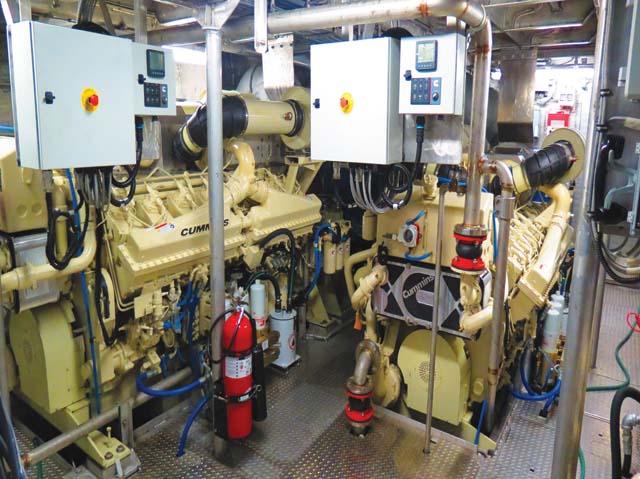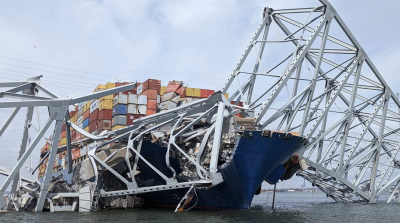The construction and delivery of the new 175'×25'×13'6", DP-2, fast supply vessel (FSV) Riley Claire was a series of firsts for the vessel’s builder, owner, and waterjet manufacturer.
For Swiftships, it is the first commercial vessel the Morgan City, La.-based yard has built since 2008 and first since announcing its return to the commercial sector just over a year ago.
“We had completed all of our Navy work and didn’t see more military work coming down,” said Jeff Leleux, Swiftships’ president. “So we said let’s do something. So we started a 175-foot spec boat and that boat became the Riley Claire.”
For Rodi Marine, the Riley Claire is the company’s first newbuild, and gives the Lafayette, La.-based operator a fleet of six vessels. (A sistership is under construction at Swiftships and is scheduled to be delivered in September.)
“We bought a 170-foot boat in May of last year to stick our toe in the deepwater market,” said Wade Guillory, one of Rodi’s owners, “and this was the next step to continue to diversify.”
Sweden-based Marine Jet Power (MJP) had been trying to break into the U.S. Gulf offshore service vessel market for a long time, and Rodi’s owners gave them a chance.
“This is the first strictly oilfield boat, first commercial FSV, we’ve put our jets in,” said Jordan Tilton, an MJP sales engineer based out of the company’s U.S. office in Columbus, Ohio.
MJP jets are on several fast ferries in the U.S., including ones in San Francisco and Boston.
TRIPLE THREAT
It was Swiftships that brought the trio together. Several years ago, the shipyard signed a contract to build patrol boats for the Iraqi government through the Foreign Military Sales program. “We built 12 patrol boats in 30 months through the FMS program,” said Leleux. “The United States was pulling out of Iraq, and the [U.S.] Navy wanted us to get those boats finished. We still have service contracts on those boats.”
Because the Navy was so strict in meeting the deadline, and Swiftships was working on another FMS contract for patrol boats for Egypt, the yard didn’t have the time or capacity to handle any commercial contracts. “They were very demanding vessels for a very demanding client,” said Leleux.
So when the FMS contracts were finished, Swiftships wanted to get the word out that it was ready to build commercial boats again. “Although we had built some fine commercial vessels in the past, we had to convince potential customers that we could build them a good boat at a reasonable price,” said Leleux.
The yard sought out customers instead of waiting for them to come to Swiftships. The spec boat was under way and people were interested.
“We were always cautious about going out on a spec boat. We started with the design we had used in the boats we delivered to DiamondOffshore and the Candy Fleet back in 2008,” said Leleux. “We weren’t pushing the building of the 175 because we had interest from several different people. We wanted to get it right.”
What Swiftships also had was an eager lender in New Orleans-based First National Bank ofCommerce. First NBC was aggressively looking for companies that needed money to build boats. “They are a local bank,” said Leleux. “They like to create opportunity for Louisiana companies.”
Meanwhile, Rodi Marine was ready to take the next step by ordering the company’s first two newbuilds. “Swiftships came to us,” said Guillory. “They were looking to get back into the commercial side of the business, and they were looking at operators.”
What Swiftships was offering was an all-welded high-speed aluminum crewboat built to ABS regulations to transport personnel and supplies to offshore facilities. “Speed and efficiency were the main selling points,” said Guillory, “and they had a lender who put together a financial package that was attractive to us.”
In the deepwater market, speed is definitely a factor, Guillory said. “They [crewboats] used to go out 100 to 150 miles, now they’re going out 200 to 250 miles,” he said.
To hit speeds of 30 knots when loaded with 70 passengers, crew, tankage (which includes 20,500 gals. rig fuel; 6,700 gals. ship’s fuel; 34,200 gals. rig water; and 1,230 gals. ship’s fresh water) and 30 LT of rear deck cargo, it was decided that MJP 650 waterjets, instead of props, were the answer.
“These boats are a little smaller than what people are building right now, but with jets we believe we’ll be more efficient,” said Guillory. “We’ll get more miles per gallon of fuel.”
Marine Jet Power had worked with Swiftships on other projects and was seeking to break into the OSV market. “We’d had a previous relationship with Swiftships, so we presented them with our material performance estimates,” said MJP’s Tilton. “I think our five-year warranty is what closed the deal.”
MJP’s waterjets are manufactured outside of Stockholm, Sweden. So convincing OSV operators that the company had enough inventory in the Gulf to prevent a boat from having to be laid up while parts are brought in from overseas was a stumbling block.
“We do have a large parts warehouse in the Morgan City area,” said Tilton. “We’ve got about a quarter of a million in parts inventory in the Gulf. We don’t want our customer sitting at the dock.”
“That was one of my pet peeves,” said Guillory, “but they’re teamed up with NREC [Marine Systems], and that’s good with me. So MJP is covering themselves down here. It’s hard coming down here and getting someone to take a chance.”
The propulsion package on the FSVs consists of the four MJP 650 waterjets connected to four Cummins QSK50 Tier 3 diesel engines, producing 1,800 hp at 1,900 rpm each, through Twin Disc MGX-6848 marine gears. “We’re going to be burning about 250 gallons per hour and running at 30-plus knots compared to a prop boat that runs at 20 to 21 knots,” said Guillory. “So we think we have an advantage there.”
Guillory said one of the advantages of the MJP waterjets is their lighter weight versus props. “Less weight means additional fuel savings for the customer,” he said. “The whole unit is lighter and smaller.”
“We are given the specs, and we tailor the intake around the boat,” said Tilton. “That’s what makes it more efficient.”
Guillory said he is happy with his new boat. “I’ve had some good experiences in building these boats,” he said. “I’m the kind of person who is very involved. I’m at the shipyard almost every day. I probably made things harder on myself than anyone else did.”
Leleux said the boatbuilding process can be a real challenge. “There’s an old saying in this business that there are only two good days in the life of a building contract — the day the contract is signed and the day it is delivered. Everything in between is hell. With that said, I have to say that working with these guys has been fantastic. I think they’re happy with the boat.”
Swiftships is expanding its facilities to handle additional commercial work. The yard has a 200' FSV due out in October and a 210' spec boat. “There’s quite a lot of interest with these boats,” said Leleux.
The yard is also building two 75'×30' pushboats. “We’re trying to get some more steel contracts,” said Leleux.
As for the Riley Claire, it is under contract and working in the Gulf of Mexico.





